Of Old Radios And Related Items--Published Monthly
The American Museum of Radio: Where Discovery Sparks Imagination
BY T.J. GRANACK
WEB EDITION
Eleven logically connected galleries in a 23,000 square foot facility, all dedicated to the preservation and interpretation of electrical apparatus, radio and its history is an exciting prospect for collectors of antique radios. The project is well underway and already open to the public. We encourage readers to follow its development via the American Museum of Radio Web site and perhaps contribute to the cause. (Editor)
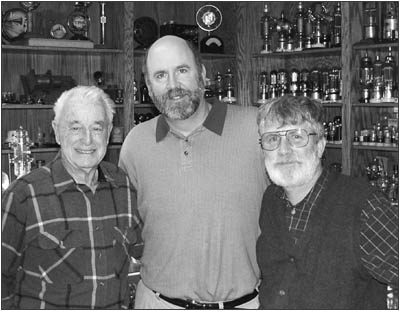
Left to right: Al Jones, John Jenkins, and Jonathan Winter. Many items from Al's tube collection can be seen in the rear.
Al Jones has one of the largest private tube collections in the world, and after bringing together over 6,000 rare and unique vacuum tubes, he felt it was time to secure a more permanent home for his priceless collection. "I didn't want to break it up," he said. "I wanted it displayed where people could appreciate what a wonderful collection it is."
After doing some serious investigating, he decided the best home for his collection was the American Museum of Radio. "I was impressed with what they're doing, " said Jones. "There isn't a museum anywhere that has a collection as great as this one and I wanted to be a part of it."
Located in Bellingham, Washington halfway between Seattle and Vancouver, Canada in the northwest corner of Washington State, the American Museum of Radio displays one of the finest, most complete collections of radios and early electrical scientific apparatus in the world. There are literally thousands of artifacts from the dawn of the electrical age (1600) through the invention of radio and the culmination of broadcasting's golden era (1950), all seamlessly displayed. By the time renovations are complete, the museum will fill over 23,000 square feet with educational and interactive exhibits, which will fascinate serious collectors, as well as the general public.
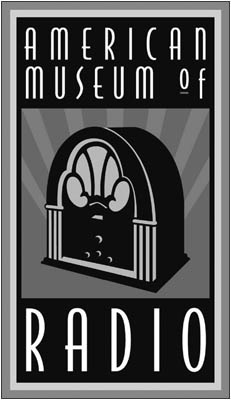
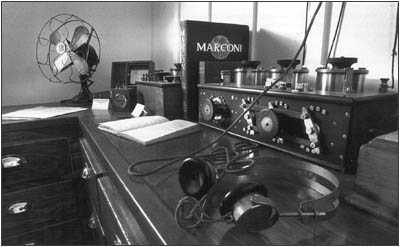
A reproduction of the wireless room as it might have been on the Titanic.
Development and Philosophy
"We could have waited until we had all the money and the building completely renovated, all the displays finished, everything perfectly placed and ready to demonstrate and present," said John Jenkins, retired Microsoft executive and museum chairman. "But, because we have this incredible collection we made a conscious decision to go ahead and open the doors now, develop a portion of the space, get the bulk of the collection out on shelves and begin to create some exhibits and interactive displays. This allows people to come in and see a world-class collection and at the same time give us feedback so we can see what works and what doesn't. It's an invaluable opportunity for learning during a period of time when we're raising money."
A basic principle governs the design of every exhibit: "At most museums the focus is on the collection," said Jenkins, "Lots of shelves, lots of radios, and lots of little white cards with model numbers. In this museum, the focus will be on the visitor. We want to create an exciting and interesting experience. We want every exhibit to invite the visitor to actually participate and experience the wonders of radio and scientific discovery." Visitors can sit in a life-size 1930s living room and tune in to a variety of classic radio programs on a vintage radio. "We want every exhibit to encourage people to touch and even operate many items in the collection," Jenkins said.
When the museum is complete, visitors will be able to send Morse code to someone in another part of the Museum; turn the crank on an early static electricity machine and store the spark in an ancient Leyden jar; even stand before a full-scale diorama with an original rare Marconi wireless set accurately reproducing the actual radio room on the Titanic. Visitors will hear the riveting sounds of the spark transmitter's haunting call for help.
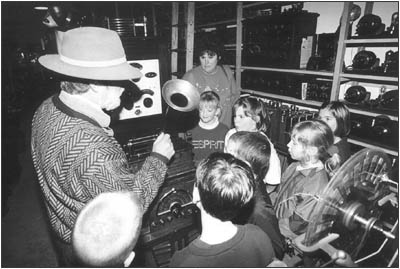
Jonathan Winter conducts a school tour.
"These pieces are so much more engaging when you can actually participate in their operation," said Jenkins.
This is exactly how Jenkins first fell in love with radio. When he was thirteen he found an old Radiola 60 in his grandparents' basement and, after a while, got it working. "I'll never forget the feeling I had when I heard music come out of that thing! Little did I know I'd be hooked forever."
The Radiola 60 was the first piece in Jenkins' collection, which is combined in the museum with that of cocurator, Jonathan Winter. The combined collection now includes more than 800 rare 1920s radios, tubes, and early electrical apparatus. It also includes rare books and publications beginning in the year 1600 with William Gilbert's De Magnete, the first book written on the phenomena of electricity and magnetism and considered one of the greatest works in the history of scientific discovery. Eleven galleries spanning six historical periods will tell the tale of exploration, discovery and scientific achievement.
"We know of no other museum in the world that starts off with the very earliest investigations into electricity and follows the thread all the way to the invention of the radio and its golden age," says Winter, who began collecting vintage radios almost 50 years ago.
The collection is so large and varied that it's difficult to know where to begin. In addition to a wonderful collection of 18th and 19th century electrostatic apparatus, the museum is filled with hundreds of crystal sets, battery and AC sets, and horn and cone speakers of every type, including the extraordinary Sarnoff speaker hand-made in Czechoslovakia for David Sarnoff. Visitors can examine numerous and rare early Marconi apparatus, including a Marconi multiple tuner and magnetic detector, or see the devices that inspired Marconi and others. There is an entire collection of unique prewireless era "Hertzian wave" devices.
A stunning collection of exceptional European radios from the 1920s dominates an entire wall. There's a variety of Crookes and Geissler tubes, a fully operational Visionola, the only known Collins Wireless Telephone (1909), and even an original 1929 RCA Theremin, which visitors are invited to play. Included when the new exhibits are completed will be an impressive collection of 16 Atwater Kent breadboards beginning with the first (a 1923 crystal set), right-up to the Model 12 and including an Atwater Kent Model 5, as well as an exciting and literally explosive 8-foot Tesla coil.
"Here you get a sense of how things developed and evolved," says Winter.
When completed, the museum will also feature a large classroom for use in the museum's science education programs, a library, radio repair shop, classrooms, gift shop, Ham shack with FCC Club License, authentic 1930s recording studio, and even a fully operational FM radio station where visitors can watch and listen as programs are produced live and broadcast from the transmission booth. The goal is to provide the local community with interesting and entertaining programming while, at the same time, reaching a wider audience through Webcasts via the Internet. "The Internet allows us to extend our exhibits beyond the four walls of the museum," adds Winter.
Funding
National support for the museum has been impressive. Nine prominent figures of the Arts, science, business, history and academia make up the Museum's national advisory board. Members include a retired shuttle astronaut, a Dartmouth professor, and the grandson of the father of wireless telegraphy, Francesco Paresce Marconi.
"The invention of radio has been compared in significance to the introduction of the printing press. It is very important that we preserve and interpret this important scientific and cultural legacy for future generations, young and old. I am impressed with the American Museum of Radio's unique approach to presenting this history and am delighted to be involved," says Dr. Paresce.
The museum is currently supported by a small group of local benefactors, as well as various state and local agencies providing grants and matching funds. At this time the museum is in the process of a national campaign to raise the capital needed to complete the planned exhibits.
"The last thing we want to do is hoard this wonderful collection," says Winter. We want to make it accessible to the world."
Anyone interested in participating in the development of this worthy endeavor can do so in a variety of ways, including the Create a Legacy Project, an opportunity to support individual displays and exhibits. This is a chance to do more than collect, but to become involved in what is emerging as one of the greatest museums of its kind anywhere in the world.
More Information
Even though the museum is still in the process of major renovations and fund raising, the bulk of the collection is available to the public now. Collectors, historians, educators, anyone wishing to stand in the center of radio history is encouraged to come to Bellingham and see the collection first hand as it is today.
"The word 'educational' doesn't quite capture what we're about," says Winter. "It's not the facts we want people to leave with, it's the inspiration. That sense of discovery and how discovery is possiblethere is so much yet to figure out."
Those who wish to participate and contribute can do so by contacting the American Museum of Radio, 1312 Bay Street, Bellingham, WA 98225. Telephone: (360) 738-3886. Web site: www.americanradiomuseum.org. The museum is open 11:00 a.m. to 4:00 p.m., Tuesday through Saturday. Private showings are available.
(T.J . Granack,c/o American Museum of Radio, 1312 Bay Street, Bellingham, WA 98225)
T.J. Granack is a writer, bartender, and lifelong radio enthusiast. He is currently working on a variety of radio scripts, which he intends to produce through the museum as soon as its FM station is complete.
American Museum of Radio--A History
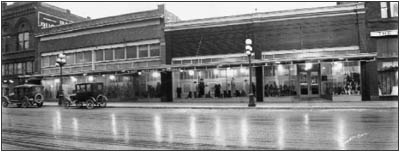
Future home of the American Museum of Radio as it appeared ca.1930 (1312 Bay Street, North and South Bay-Facade). Sandison Collection, Whatcom Museum of History & Art.
Visit the Web site for the American Museum of Radio to learn much more about the museum, the vision, the planned exhibits, the capital campaign and how you can participate. Here in part is the history of the museum as reported on the Web site, written by Cheryll Greenwood Kinsley. (Editor)
The vision that evolved into the American Museum of Radio was born a half-century ago in Santa Barbara, California. A young man named Jonathan Winter was captivated by the programs and music that came from old radios. He loved tinkering with them and began to collect as many as he could. Through the years, he accumulated spare parts, too, along with schematics, recordings, and old magazines and manuals.
In 1985, he found a small space in the oldest part of Bellingham, Washington, and began to share his collection with other like-minded radio fans. He was a little surprised to see that a steady stream of visitors found their way to this new "museum." Without any formal publicity, word-of-mouth brought radio buffs, hobbyists, and collectors, as well as older folks whose memories of the past were rekindled by a glimpse of a radio from their childhood, and schoolchildren of today, some in search of information for science. Real publicity arrived soon after, as the museum was featured in ABC television's An American Moment, narrated by James Earl Jones.
Jonathan soon had to find a slightly larger space and then another, as the collection grew and the number of visitors increased. Over the years, the Bellingham Antique Radio Museum functioned as a gathering place in the community, almost as if it were a radio shop of the 1930s. But it sold nothing. Instead, visitors were offered a unique, hands-on opportunity to visit an earlier time. They could handle vintage radios and actually experience the wonder of broadcast and entertainment technology from the early 20th Century.
This was all made official in 1998 with the establishment of the Bellingham Antique Radio Museum as a nonprofit organization under Section 501 (c) (3) of the Internal Revenue Service Code. Jonathan Winter's collection of more than 800 rare radios from the 1920s formed the foundation of the museum's collection. He became president and curator; an active and committed Board of Directors was assembled; and planning for the future began in earnest.
In 1995, another devotee of early radio discovered the Bellingham Antique Radio Museum. John Jenkins, struck in his youth by the same spark as Jonathan Winter, had become an avid collector of vintage radios, related scientific apparatus, and rare books and manuscripts about early investigations into the phenomenon of electricity. His collecting and his involvement with the museum garnered his full attention when he retired as general manager of worldwide sales and marketing for the Microsoft Corporation in February of 2001. He became vice president and cocurator of the Bellingham Antique Radio Museum, working side-by-side with Jonathan Winter.
It was the generosity of John Jenkins and his commitment to the museum's mission that made possible its expansion into more spacious quarters in June of 2001. The Bellingham Antique Radio Museum has become the American Museum of Radio, launched into its new space with a new name to reflect its distinctive mission. Today John Jenkins serves as cocurator and chairman of the Board of Directors for the American Museum of Radio, while Jonathan Winter continues as president.
The American Museum of Radio is a powerhouse of educational possibilities, a place where visitors can take a journey back in time, and electrify their imaginations.
| [Free Sample] [Books, etc., For Sale] [Subscribe to A.R.C./Renew] [Classified Ads] [Auction Prices] [Event Calendar] [Links] [Home] [Issue Archives] [Book Reviews] [Subscription Information] [A.R.C. FAQ] URL = http://www.antiqueradio.com/Mar03_Granack_Museum.html Copyright © 1996-2002 by John V. Terrey - For personal use only. Last revised: March 10, 2002. For Customer Assistance please contact ARC@antiqueradio.com or call (866) 371-0512 Pages designed/maintained by Wayward Fluffy Publications
Antique Radio Classified |